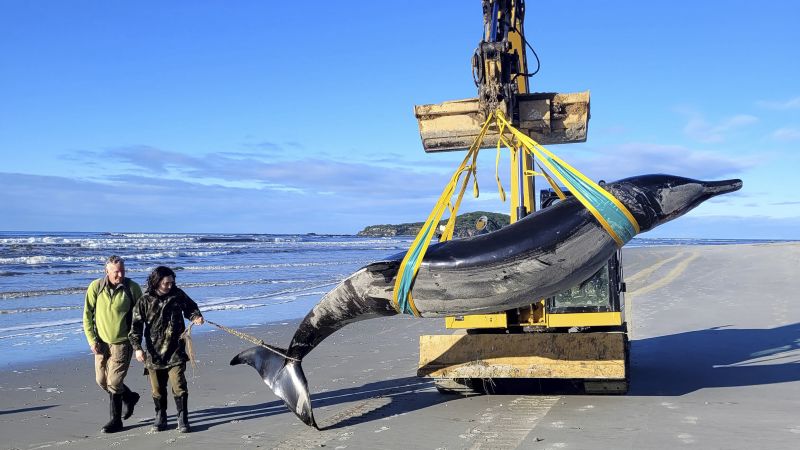In July, marine biologist Anton van Helden found himself in a rather unusual situation. Having just undergone surgery, he was recuperating at home when a photograph on his phone revealed something extraordinary—a spade-toothed whale had washed ashore. Van Helden, who serves as a senior marine science adviser for New Zealand’s Department of Conservation (DOC), was both shocked and excited. His immediate reaction was one of disbelief mixed with enthusiasm, exclaiming, “Oh my goodness, it’s a spade-toothed whale!” Recognizing that this creature represents one of the rarest aquatic mammals—only seven recorded individuals of this species—he anticipated doubts from his peers.
The spade-toothed whale is a creature of legend within marine science, primarily due to its elusive nature and the fact that it has never been spotted alive at sea. When this near-mythical animal was found mostly intact, many questioned its authenticity. Nevertheless, this event prompted the gathering of top whale scientists and local Māori community members in New Zealand, marking a historic moment—the first time anyone was able to explore the anatomy of a spade-toothed whale.
As a member of the beaked whale family, the spade-toothed whale is distinctive for its “dolphin-like” snout. It is a part of a group known for their enigmatic nature, often diving to incredible depths in pursuit of food. Notably, the goose-beaked whale holds the world record for the deepest and longest recorded dive by any whale, reaching almost three kilometers and lasting three hours and 42 minutes. The existence of the spade-toothed whale was first established through jaw and teeth samples collected on Pitt Island in 1874, with further evidence emerging through partial skull discoveries in New Zealand and Chile.
The first sighting of a live spade-toothed whale occurred in 2010, when a mother and calf stranded themselves off New Zealand’s North Island. Unfortunately, those carcasses were not suitable for scientific examination. Another incident in 2017 saw another specimen stranding, but the 2023 event in July represented a unique research opportunity. When the whale beached near the Taiari River, the local tribal authority, Te Rūnanga o Ōtākou, recognized the significance of the discovery and quickly preserved the specimen for future study.
Tumai Cassidy, a cultural advisor for the tribal authority, emphasized the importance of whales to their community, noting that they are revered creatures deserving of respect. They named the whale Ōnumia, reflecting the traditional name for the area where it was found. The dissection was conducted in partnership with the DOC to promote the exchange of scientific and cultural knowledge, and Cassidy highlighted the collective responsibility everyone shares in preserving animal life.
The dissection process itself was a complex undertaking. Scientists commenced their examination with external measurements and the analysis of fat beneath the whale’s skin. Plans were made to conduct a CT scan of its head following a detailed analysis. Van Helden expressed a keen interest in understanding how the whale produces sound, given its life spent in the ocean depths. Observations during the dissection revealed startling physical characteristics, with van Helden noting how the spade-toothed whale appeared shorter and more robust than other beaked whales. He described it as “really stocky, powerful-looking,” while humorously reminding listeners of the creature’s overall size and mass.
This momentous event has opened the door for further scientific inquiries into the unique adaptations of the spade-toothed whale. Experts like van Helden, despite their extensive knowledge of marine mammals, find themselves pondering more questions than they can currently answer about this extraordinary species. The collaborative effort among scientists and Māori community members not only pays homage to the whale but also underscores the importance of unity in scientific exploration and environmental stewardship. With each dissection cut, new revelations about the elusive depths of the ocean and its inhabitants are unveiled, bringing to light the mysteries of one of nature’s most elusive creatures.



